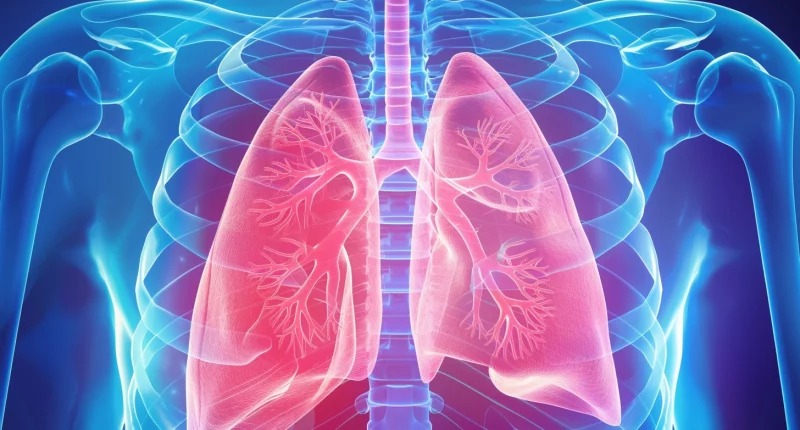Chronic obstructive pulmonary disease (COPD)
What’s that?
Chronic obstructive pulmonary disease, or COPD, is a common pathology of the bronchopulmonary system. It is based on a chronic inflammatory process in the bronchi, which leads to changes in the wall of the bronchial tree, the release of large amounts and impaired evacuation of sputum, and, as a result – impaired air movement through the bronchi. The lungs become overfilled with air; lung emphysema is formed, then chronic respiratory failure.
About the disease
The danger of chronic obstructive pulmonary disease lies in late diagnosis because its symptoms are nonspecific and, at the initial stages of the pathological process, almost invisible externally. Nevertheless, not visible inflammation steadily progresses, leading to irreversible changes in the bronchial wall and impaired function of the bronchi and lungs.
COPD is among the top three leading causes of mortality, behind ischemic heart disease and acute cerebral circulatory disorders.
In COPD, the normal function of immune mechanisms is disturbed, and the structure and function of the inner bronchial membrane are altered. Mucus in the bronchi is produced in large quantities, and mucus viscosity increases, which creates a favorable environment for bacterial growth and destruction of the bronchial wall. It causes a violation of bronchial patency; lung emphysema is formed, pneumosclerosis and respiratory failure progresses.
Types
The severity of COPD is determined by impaired bronchial patency. It, as in the case of bronchial asthma, can be assessed quantitatively by determining the parameters of external respiratory function. In the course of chronic obstructive pulmonary disease, there are four stages, differing in clinical manifestations and the nature of changes in the spirogram:
- I, or mild COPD – manifested by non-intensive chronic cough with mucous sputum; spirography reveals a decrease in the ratio of forced expiratory volume in 1 sec. (FEV1) to the functional vital capacity of the lungs (FVC) is less than 70%, and FEV1 is within normal values – more than 80% of the proper.
- II, or moderately severe COPD – the intensity of cough with sputum increases, FEV1 – decreases, being less than 80% of the proper values, FEV1/FVC – less than 50%.
- III, or severe COPD – FEV1 is less than 50% of the proper value, FEV1/FVC is less than 30%; cough with sputum becomes more and more severe, bothers the patient almost constantly during the day;
- IV, extremely severe COPD – FEV1 is less than 30%; the person is bothered by symptoms of right ventricular insufficiency or chronic respiratory failure.
Symptoms
The main symptoms of COPD are cough with sputum and shortness of breath. At the initial stage of the disease, the cough is episodic, the amount of sputum is small, dyspnea occurs only with intense physical activity, and in its severe course, the cough is constant, dyspnea is noted at rest, there are signs of right ventricular insufficiency (swelling of the legs; heaviness in the right subcostal area). In the case of secondary infection, sputum becomes purulent, cough significantly increases, and there are signs of intoxication and distant wheezing.
COPD is a chronic disease with alternating periods of exacerbation and remission. Exacerbations occur more often under the influence of infection – bacterial or viral. The severity of the exacerbation and the therapy strategy depends on the infectious agent.
Frequent infections lead to a decrease in local defense at the bronchial level and contribute to the progression of chronic inflammation. In the remission stage, COPD is asymptomatic – cough is not intense, and sputum is often mucous. Nevertheless, even outside the exacerbation, the patient is bothered by heaviness in the chest, dyspnea, and symptoms of intoxication – weakness, fatigue, and subfebrile fever.
Reasons
The leading cause of the disease is smoking, and the longer a smoker’s smoking history (duration of the bad habit, number of cigarettes smoked per day), the higher the risk of developing COPD. Other risk factors:
- some environmental factors (sulfur dioxide, nitrogen dioxide, ozone);
- occupational hazards (pathology is often diagnosed in miners, construction workers, and workers in contact with cement, metal processing, etc.);
- genetic factors;
- adenovirus infection.
Diagnosis
The basis for the diagnosis of chronic obstructive pulmonary disease is:
- collection of complaints, life, and medical history;
- objective examination (during the examination may be found signs of chronic bronchitis may be pallor or diffuse cyanosis of the skin, deformation of the terminal phalanges of fingers in the form of drumsticks, wide, shiny nails, rapid, heavy breathing, wheezing in the lungs when listening, barrel-shaped, slow-moving when breathing chest);
- additional diagnostic methods (general blood analysis, sputum analysis, spirometry, peak flow meter, chest radiography, pulse oximetry).
Only when the final diagnosis of COPD has been established, taking into account the data of all stages of the study, can the patient be prescribed a therapy regimen.
Treatment
The treatment of COPD is always comprehensive. It includes:
- eliminating the impact on the body of factors that provoke the disease;
- baseline therapy (prolonged-acting or short-acting bronchodilators);
- topical corticosteroids (have a powerful anti-inflammatory effect);
- medicines that thin sputum and make it easier to get out of the bronchi;
- antipyretics during an exacerbation.
Surgical Treatment
Although surgical treatment is not very common for treating this disease, several options are still available:
- Lung Volume Reduction Surgery (LVRS): LVRS is performed on patients with severe emphysema, a subtype of COPD. The procedure involves removing diseased, non-functioning parts of the lung, which allows the remaining, healthier lung tissue to expand and work more efficiently, and the diaphragm and chest wall muscles to function more effectively. LVRS has been shown to improve the quality of life, lung function, and exercise capacity in selected patients.
- Bullectomy: In emphysema, large air spaces called bullae form in the lungs. A bullectomy removes one or more of these large bullae to help improve lung function. This procedure can relieve symptoms of breathlessness caused by the bullae obstructing air exchange in the lungs.
- Lung Transplantation: Lung transplantation is considered for patients with very severe COPD who have not improved with other treatments. It involves replacing the diseased lung(s) with a healthy lung(s) from a donor. Lung transplantation is a complex and significant procedure with potential risks and complications, but it can offer a chance for improved lung function and quality of life in selected patients.
All these treatment options are available in more than 540 hospitals worldwide (https://doctor.global/results/diseases/chronic-obstructive-pulmonary-disease-copd). For example, Lung volume reduction surgery can be performed in 26 clinics across Germany (https://doctor.global/results/europe/germany/all-cities/all-specializations/procedures/lung-volume-reduction-surgery-lvrs).
Prevention
Primary prevention of COPD consists of following a healthy lifestyle (smoking cessation) and minimizing exposure of the bronchopulmonary apparatus to substances that may underlie the disease.
Secondary prevention includes vaccination against influenza and pneumococcal infection and timely and adequate treatment of bronchopulmonary infections, considering the identified pathogen.
Rehabilitation
COPD is a steadily progressive chronic disease from which it is impossible to recover. However, compliance with all therapeutic and preventive measures given by the doctor will help reduce the inflammatory process’s activity during an exacerbation and maintain the achieved remission for as long as possible. In the subacute or remission period, the patient is recommended such rehabilitation measures as physiotherapy and sanatorium-resort treatment.



